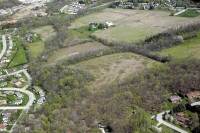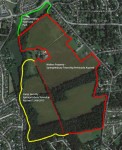 The only Revolutionary War POW camp to survive in undeveloped condition has been saved for posterity thanks to donations from the public. When I first wrote about Camp Security last April, the 47-acre plot in Springettsbury Township, Pennsylvania, between the city of York and the Susquehanna River, was in danger of being sold. More than half a million dollars of a bridge loan secured by non-profit The Conservation Fund for its purchase was still outstanding, and if the money couldn’t be raised by August, the Fund might have to sell the land or face disastrous budgetary consequences.
The only Revolutionary War POW camp to survive in undeveloped condition has been saved for posterity thanks to donations from the public. When I first wrote about Camp Security last April, the 47-acre plot in Springettsbury Township, Pennsylvania, between the city of York and the Susquehanna River, was in danger of being sold. More than half a million dollars of a bridge loan secured by non-profit The Conservation Fund for its purchase was still outstanding, and if the money couldn’t be raised by August, the Fund might have to sell the land or face disastrous budgetary consequences.
They must have gotten an extension on that bridge loan, because at the end of the July they were still $250,000 short and there was no news I could find in August, but come December, the Springettsbury Township announced that the full sum had been raised and that The Conservation Fund had transferred the deed to the property to the township. Thanks to more than a decade of hard work from the township, The Conservation Fund, York County, the York County Heritage Trust, the state Department of Conservation and Natural Resources and Friends of Camp Security, plus donations from people all over the country, the field now belongs to the township in perpetuity.
 It joins an adjacent 115-acre parcel and a small park that already belong to the township to form a large public open space. Hunting and digging are prohibited, but people can walk it or picnic on it or throw frisbees to their hearts’ content. The overall plans for the property include environmental preservation, historic preservation and archaeological exploration.
It joins an adjacent 115-acre parcel and a small park that already belong to the township to form a large public open space. Hunting and digging are prohibited, but people can walk it or picnic on it or throw frisbees to their hearts’ content. The overall plans for the property include environmental preservation, historic preservation and archaeological exploration.
On Monday, the excavation of the Camp Security site began. There was limited survey on a small section of the site in 1979 that returned thousands of Revolutionary War artifacts — that’s how it was identified as the location of Camp Security — but this is the first time archaeologists and volunteers will really get to explore the site. More than 75 people have volunteered to help. They will work four-hour shifts over 25 days in the field.
Since the site has been plowed by a farmer, volunteers will first scan the surface for artifacts. Next the team will dig about 100 holes looking for evidence of the two camps built on the site. Camp Security was the POW camp — sharpened picket fence, wooden stockade and fieldstone cabins — built by prisoners when they arrived in August of 1781. Outside the picket fence was Camp Indulgence, unenclosed fieldstone huts built to house the wives and children who followed their husbands.
 Most of this first group of prisoners had been captured after the surrender of General John Burgoyne at Saratoga, New York, in 1777. They were used to living in America, despite have experienced considerable hardships during nearly four years of imprisonment, and at Camp Security they were given many freedoms. They could work — gets jobs or run their own cottage industries — travel freely within 10 miles of the camp, and even live with their families at Camp Indulgence. It was the newer prisoners, particularly those captured after Cornwallis’ defeat at Yorktown in October of 1781, who were confined to Camp Security and closely guarded. Once the archaeological team identifies the location of one of the camps, they can figure out where the other one is.
Most of this first group of prisoners had been captured after the surrender of General John Burgoyne at Saratoga, New York, in 1777. They were used to living in America, despite have experienced considerable hardships during nearly four years of imprisonment, and at Camp Security they were given many freedoms. They could work — gets jobs or run their own cottage industries — travel freely within 10 miles of the camp, and even live with their families at Camp Indulgence. It was the newer prisoners, particularly those captured after Cornwallis’ defeat at Yorktown in October of 1781, who were confined to Camp Security and closely guarded. Once the archaeological team identifies the location of one of the camps, they can figure out where the other one is.
For more about the history of Camp Security, check out local historian June Lloyd’s fantastic York Blog.